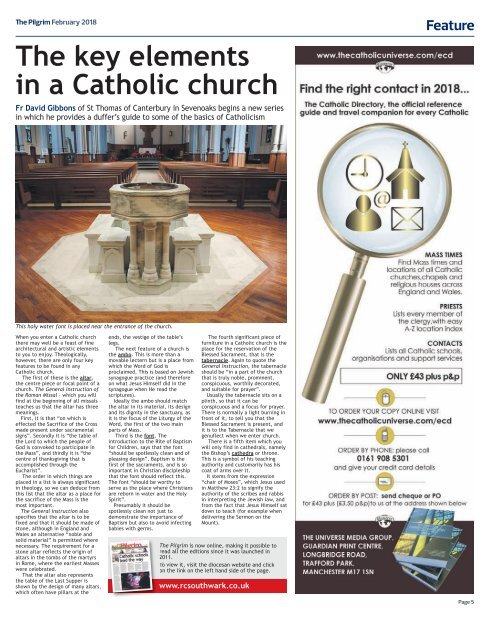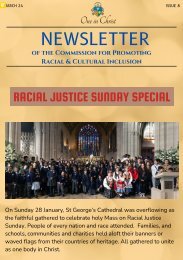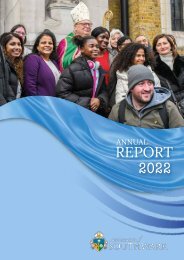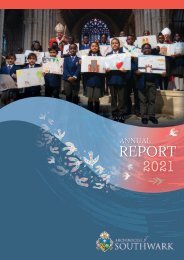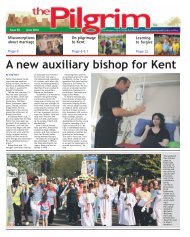Issue 68 - The Pilgrim - February 2018 - The newspaper of the Archdiocese of Southwark
The February 2018 issue of "The Pilgrim", the newspaper of the Archdiocese of Southwark
The February 2018 issue of "The Pilgrim", the newspaper of the Archdiocese of Southwark
Create successful ePaper yourself
Turn your PDF publications into a flip-book with our unique Google optimized e-Paper software.
<strong>The</strong> <strong>Pilgrim</strong> <strong>February</strong> <strong>2018</strong><br />
Feature<br />
<strong>The</strong> key elements<br />
in a Catholic church<br />
Fr David Gibbons <strong>of</strong> St Thomas <strong>of</strong> Canterbury in Sevenoaks begins a new series<br />
in which he provides a duffer’s guide to some <strong>of</strong> <strong>the</strong> basics <strong>of</strong> Catholicism<br />
This holy water font is placed near <strong>the</strong> entrance <strong>of</strong> <strong>the</strong> church.<br />
When you enter a Catholic church<br />
<strong>the</strong>re may well be a feast <strong>of</strong> fine<br />
architectural and artistic elements<br />
to you to enjoy. <strong>The</strong>ologically,<br />
however, <strong>the</strong>re are only four key<br />
features to be found in any<br />
Catholic church.<br />
<strong>The</strong> first <strong>of</strong> <strong>the</strong>se is <strong>the</strong> altar,<br />
<strong>the</strong> centre piece or focal point <strong>of</strong> a<br />
church. <strong>The</strong> General Instruction <strong>of</strong><br />
<strong>the</strong> Roman Missal – which you will<br />
find at <strong>the</strong> beginning <strong>of</strong> all missals –<br />
teaches us that <strong>the</strong> altar has three<br />
meanings.<br />
First, it is that “on which is<br />
effected <strong>the</strong> Sacrifice <strong>of</strong> <strong>the</strong> Cross<br />
made present under sacramental<br />
signs”. Secondly it is “<strong>the</strong> table <strong>of</strong><br />
<strong>the</strong> Lord to which <strong>the</strong> people <strong>of</strong><br />
God is convoked to participate in<br />
<strong>the</strong> Mass”, and thirdly it is “<strong>the</strong><br />
centre <strong>of</strong> thanksgiving that is<br />
accomplished through <strong>the</strong><br />
Eucharist”.<br />
<strong>The</strong> order in which things are<br />
placed in a list is always significant<br />
in <strong>the</strong>ology, so we can deduce from<br />
this list that <strong>the</strong> altar as a place for<br />
<strong>the</strong> sacrifice <strong>of</strong> <strong>the</strong> Mass is <strong>the</strong><br />
most important.<br />
<strong>The</strong> General Instruction also<br />
specifies that <strong>the</strong> altar is to be<br />
fixed and that it should be made <strong>of</strong><br />
stone, although in England and<br />
Wales an alternative “noble and<br />
solid material” is permitted where<br />
necessary. <strong>The</strong> requirement for a<br />
stone altar reflects <strong>the</strong> origin <strong>of</strong><br />
altars in <strong>the</strong> tombs <strong>of</strong> <strong>the</strong> martyrs<br />
in Rome, where <strong>the</strong> earliest Masses<br />
were celebrated.<br />
That <strong>the</strong> altar also represents<br />
<strong>the</strong> table <strong>of</strong> <strong>the</strong> Last Supper is<br />
shown by <strong>the</strong> design <strong>of</strong> many altars,<br />
which <strong>of</strong>ten have pillars at <strong>the</strong><br />
ends, <strong>the</strong> vestige <strong>of</strong> <strong>the</strong> table’s<br />
legs.<br />
<strong>The</strong> next feature <strong>of</strong> a church is<br />
<strong>the</strong> ambo. This is more than a<br />
movable lectern but is a place from<br />
which <strong>the</strong> Word <strong>of</strong> God is<br />
proclaimed. This is based on Jewish<br />
synagogue practice (and <strong>the</strong>refore<br />
on what Jesus Himself did in <strong>the</strong><br />
synagogue when He read <strong>the</strong><br />
scriptures).<br />
Ideally <strong>the</strong> ambo should match<br />
<strong>the</strong> altar in its material, its design<br />
and its dignity in <strong>the</strong> sanctuary, as<br />
it is <strong>the</strong> focus <strong>of</strong> <strong>the</strong> Liturgy <strong>of</strong> <strong>the</strong><br />
Word, <strong>the</strong> first <strong>of</strong> <strong>the</strong> two main<br />
parts <strong>of</strong> Mass.<br />
Third is <strong>the</strong> font. <strong>The</strong><br />
introduction to <strong>the</strong> Rite <strong>of</strong> Baptism<br />
for Children, says that <strong>the</strong> font<br />
“should be spotlessly clean and <strong>of</strong><br />
pleasing design”. Baptism is <strong>the</strong><br />
first <strong>of</strong> <strong>the</strong> sacraments, and is so<br />
important in Christian discipleship<br />
that <strong>the</strong> font should reflect this.<br />
<strong>The</strong> font “should be worthy to<br />
serve as <strong>the</strong> place where Christians<br />
are reborn in water and <strong>the</strong> Holy<br />
Spirit”.<br />
Presumably it should be<br />
spotlessly clean not just to<br />
demonstrate <strong>the</strong> importance <strong>of</strong><br />
Baptism but also to avoid infecting<br />
babies with germs.<br />
<strong>The</strong> fourth significant piece <strong>of</strong><br />
furniture in a Catholic church is <strong>the</strong><br />
place for <strong>the</strong> reservation <strong>of</strong> <strong>the</strong><br />
Blessed Sacrament, that is <strong>the</strong><br />
tabernacle. Again to quote <strong>the</strong><br />
General Instruction, <strong>the</strong> tabernacle<br />
should be “in a part <strong>of</strong> <strong>the</strong> church<br />
that is truly noble, prominent,<br />
conspicuous, worthily decorated,<br />
and suitable for prayer”.<br />
Usually <strong>the</strong> tabernacle sits on a<br />
plinth, so that it can be<br />
conspicuous and a focus for prayer.<br />
<strong>The</strong>re is normally a light burning in<br />
front <strong>of</strong> it, to tell you that <strong>the</strong><br />
Blessed Sacrament is present, and<br />
it is to <strong>the</strong> Tabernacle that we<br />
genuflect when we enter church.<br />
<strong>The</strong>re is a fifth item which you<br />
will only find in ca<strong>the</strong>drals, namely<br />
<strong>the</strong> Bishop’s ca<strong>the</strong>dra or throne.<br />
This is a symbol <strong>of</strong> his teaching<br />
authority and customarily has his<br />
coat <strong>of</strong> arms over it.<br />
It stems from <strong>the</strong> expression<br />
“chair <strong>of</strong> Moses”, which Jesus used<br />
in Mat<strong>the</strong>w 23:2 to signify <strong>the</strong><br />
authority <strong>of</strong> <strong>the</strong> scribes and rabbis<br />
in interpreting <strong>the</strong> Jewish law, and<br />
from <strong>the</strong> fact that Jesus Himself sat<br />
down to teach (for example when<br />
delivering <strong>the</strong> Sermon on <strong>the</strong><br />
Mount).<br />
<strong>The</strong> <strong>Pilgrim</strong> is now online, making it possible to<br />
read all <strong>the</strong> editions since it was launched in<br />
2011.<br />
To view it, visit <strong>the</strong> diocesan website and click<br />
on <strong>the</strong> link on <strong>the</strong> left hand side <strong>of</strong> <strong>the</strong> page.<br />
www.rcsouthwark.co.uk<br />
Page 5


